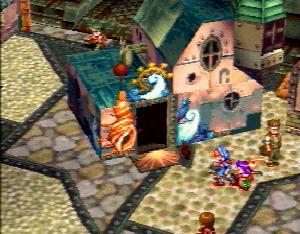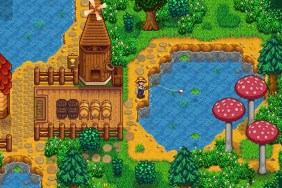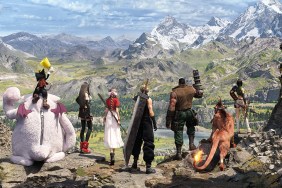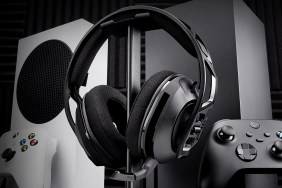A Grand Day Out
Justin wants to be just like his father–an adventurer. Unlike the many angst-ridden, emotionally tormented heroes of the RPG world (could it be because so many RPG children have negligent parents?), Justin is well adjusted and dreams of going to far off continents, meeting new people, and discovering ancient civilizations along the way.
The world was once thought to be round, but then, at the edge of the world,
a great wall was discovered. Many years ago, Justin’s father disappeared on
a journey to cross over the wall. With his friend Sue and her pet Puffy, the
obligatory furry creature that only speaks Puffy language, Justin seeks to go
beyond the End of the World and find out what lies waiting for him on the other
side.
Grandia
is a continent spanning role-playing game in the old school tradition. By that,
I mean the focus isn’t nearly so heavy on graphics and flash, allowing you to
really notice and appreciate the characters, plot, and gameplay. For example,
townspeople have many things to tell you each time you talk to them, creating
the illusion of a real town where the local people are more than cardboard cutouts.
From the guy covered in bird droppings to the vomiting woman, this game has
personality in spades. I haven’t laughed like this during a game since Sam
and Max for the PC.
The fight system uses a combination of turn-based style with a time-based meter. The time meter starts out dependent on how you met up with your enemy. If you approach the enemy first, you get the initiative in battle. Or, you could be ambushed, giving the advantage to the enemy.
While time passes in battle, you and the enemy will be on standby until the command point of the time meter is reached. When one of your characters reaches that point, the action pauses and you choose what that character will do. The more developed your character is, the faster your command will happen after being selected. With a well-chosen attack at the right time, you can delay or even cancel your enemy’s attacks.
Practically everything in the game can be developed. Weapons and magic both have their own experience points. By using different types of weapons, from swords to whips and so on, you will develop different statistics and eventually gain special attacks.
You start out in Grandia without magic, but by finding Mana Eggs, you can buy an element type at the local weapons store. By combining the four elements with one another, you can access a second tier of element types (i.e. Fire combined with Earth, makes Explosion . . . which apparently is an element). With each spell you use, you increase your magic ability and gain more powerful spells
The experience system in Grandia works very well with the battle setup. Every choice you make in battle gets tallied up at the end and calculated into your character. If you made effective use of a fire spells, you’ll get more points for the fire element. Sure, you can just simply fight your way through battles, but in the long run, you’ll find yourself playing with an unbalanced character. The promise of new spells and attacks keeps the battles varied and fun.
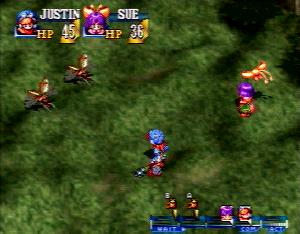 The
The
flow of the game is strictly linear, but not in a bad way. You get to a village,
you find out your next trial or adventure is, and then you set out to do it.
When you get back, you find out the next village or stop on your journey, and
repeat. It sounds repetitious, but the game manages to keep the plot moving
and interesting.
Your party moves around a colorful polygonal world. Villages are filled with detail and life. Fields of terrain range from expansive to maze-like. Overall, it’s a throwback look done with outdated, but still pretty, graphics. The biggest problem of the whole game is that in areas of more graphically taxing terrain, there are dips in the framerates: running speeds become noticeably slower. For me, it was something to get used to, rather than bothered by, but some gamers might get annoyed.
Characters are well-animated sprites overlaid on the three dimensional backdrop; during battles, a two dimensional slightly blurry still-shot is used for the background. I would have liked it if the battles shared the same backgrounds as the terrain, a la Chrono Trigger, but that might have added more slowdown. Thankfully, with the 2D backgrounds, there isn’t any slowdown during the fights.
Throughout the game, the music is pretty good. Most of the tunes are upbeat, with some distinctive cultural music mixed in to certain tracks. The variation adds a nice touch to the idea of going around the world. Also, at key moments during the game, characters speak audibly. Voices! Hooray! The supporting cast varies in performance, but at least the main characters are right on the money.
There are some really minor snafus that were somewhat bothersome, but didn’t really detract from the game. At every save point, there’s a recover option. Allowing a recover option makes Grandia a lot easier, but then again, it also promotes fighting more battles and raising statistics. It also seems to take an inexplicably long time to load and save the game. In the translation to English, I wonder why they chose to name a race the “Angelou.” Every time I saw the word Angelou, the word Maya popped in my head. And then there’s Guido–the Jar Jar Binks of the Grandia world. ‘Nuff said.
Where Final Fantasy 8 moved in broad strokes, Grandia focused on the little details. With an emphasis on characterizations, and battles that are actually fun to play, this game totally grabbed me. Yes, there are the framerate problems, and the graphics are in the shadow of that other RPG, but Grandia is truer to what is at the heart of the best RPGs–a grand adventure.
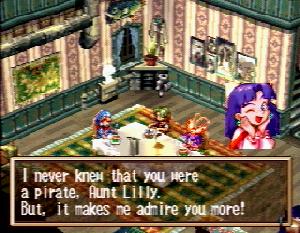
-
Interesting Characters
-
Battle System
-
Statistic building
-
Funny
-
Old school fun
-
Some framerate issues
